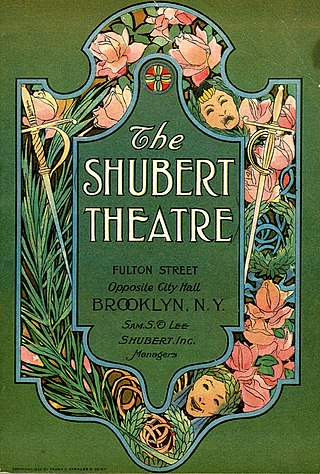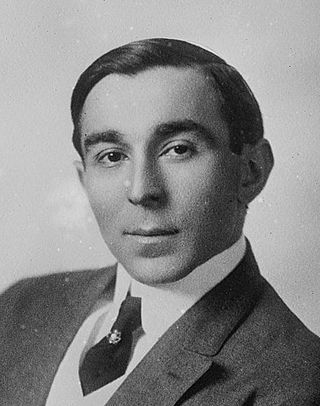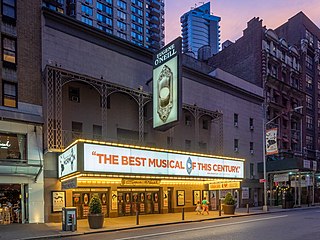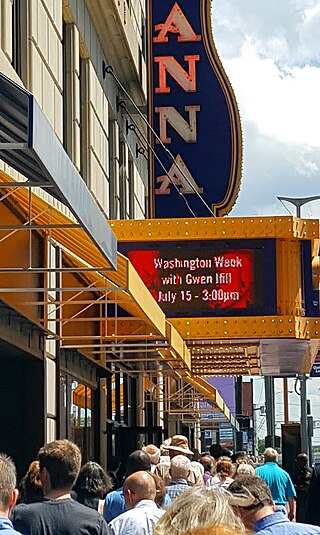
The Shubert Organization is a theatrical producing organization and a major owner of theatres based in Manhattan, New York City. It was founded by the three Shubert brothers — Lee, Sam, and Jacob J. Shubert — in the late 19th century. They steadily expanded, owning many theaters in New York and across the United States. Since then it has gone through changes of ownership, but it is still a major theater chain.

The Shubert family was responsible for the establishment of Broadway theaters in New York City's Theater District, as the hub of the theatre industry in the United States. Through the Shubert Organization, founded by brothers Lee, Sam, and Jacob Shubert, they dominated the legitimate theatre and vaudeville in the first half of the 20th century.

Abraham Lincoln Erlanger was an American theatrical producer, director, designer, theater owner, and a leading figure of the Theatrical Syndicate.

The New Amsterdam Theatre is a Broadway theater at 214 West 42nd Street, at the southern end of Times Square, in the Theater District of Manhattan in New York City. One of the first Broadway venues to open in the Times Square neighborhood, the New Amsterdam was built from 1902 to 1903 to designs by Herts & Tallant. The theater is operated by Disney Theatrical Productions and has 1,702 seats across three levels. Both the Beaux-Arts exterior and the Art Nouveau interior of the building are New York City landmarks, and the building is on the National Register of Historic Places.

The St. James Theatre, originally Erlanger's Theatre, is a Broadway theater at 246 West 44th Street in the Theater District of Midtown Manhattan in New York City. Opened in 1927, it was designed by Warren and Wetmore in a neo-Georgian style and was constructed for A. L. Erlanger. It has 1,709 seats across three levels and is operated by ATG Entertainment. Both the facade and the auditorium interior are New York City landmarks.

The Shubert Theatre is a Broadway theater at 225 West 44th Street in the Theater District of Midtown Manhattan in New York City. Opened in 1913, the theater was designed by Henry Beaumont Herts in the Italian Renaissance style and was built for the Shubert brothers. Lee and J. J. Shubert had named the theater in memory of their brother Sam S. Shubert, who died in an accident several years before the theater's opening. It has 1,502 seats across three levels and is operated by The Shubert Organization. The facade and interior are New York City landmarks.

The Walter Kerr Theatre, previously the Ritz Theatre, is a Broadway theater at 219 West 48th Street in the Theater District of Midtown Manhattan in New York City. The theater was designed by Herbert J. Krapp and was constructed for the Shubert brothers in 1921. The venue, renamed in 1990 after theatrical critic Walter Kerr, has 975 seats across three levels and is operated by ATG Entertainment. The facade is plainly designed and is made of patterned brick. The auditorium contains Adam-style detailing, two balconies, and murals.

The Eugene O'Neill Theatre, previously the Forrest Theatre and the Coronet Theatre, is a Broadway theater at 230 West 49th Street in the Theater District of Midtown Manhattan in New York City. The theater was designed by Herbert J. Krapp and was constructed for the Shubert brothers. It opened in 1925 as part of a hotel and theater complex named after 19th-century tragedian Edwin Forrest. The modern theater, named in honor of American playwright Eugene O'Neill, has 1,108 seats across two levels and is operated by ATG Entertainment. The auditorium interior is a New York City designated landmark.

Herbert J. Krapp (1887–1973) was a 20th-century theatre architect and designer, notable for his contributions to Broadway theater district architecture. Known for his innovative approach to design, his built work favors width, rather than depth, to create better sightlines for an "intimate theatre" experience.
The Center Theatre was a theater located at 1230 Sixth Avenue, the southeast corner of West 49th Street in Rockefeller Center in New York City. Seating 3,500, it was originally designed as a movie palace in 1932 and later achieved fame as a showcase for live musical ice-skating spectacles. It was demolished in 1954, the only building in the original Rockefeller Center complex to have been torn down.

The Hanna Theatre is a theater at Playhouse Square in downtown Cleveland, Ohio, United States. It is one of the original five venues built in the district, opening on March 28, 1921. The Hanna Theatre reopened in 2008 as the new home of Great Lakes Theater Festival after a major renovation by the classic theater company.

The 44th Street Theatre was a Broadway theater at 216 West 44th Street in the Theater District of Manhattan in New York City from 1912 to 1945. It was originally named Weber and Fields' Music Hall when it opened in November 1912 as a resident venue for the comedy duo Weber and Fields, but was renamed to the 44th Street Theatre in December 1913 after their tenure at the theatre ended. It should not be confused with the Weber and Fields' Broadway Music Hall, often referred to as simply Weber and Fields' Music Hall and also known as Weber's Music Hall or Weber's Theatre, which was used by both Weber and Fields or just Weber from 1896 through 1912.

The Broadway Theater District in the Historic Core of Downtown Los Angeles is the first and largest historic theater district listed on the National Register of Historic Places (NRHP). With twelve movie palaces located along a six-block stretch of Broadway, it is the only large concentration of movie palaces left in the United States. The same six-block stretch of Broadway, and an adjacent section of Seventh Street, was also the city's retail hub for the first half of the twentieth century, lined with large and small department stores and specialty stores.

The Forrest Theatre is a live theatre venue at 1114 Walnut Street Center City area of Philadelphia, Pennsylvania. It has a seating capacity of 1,851 and is managed by The Shubert Organization.

Shubert Alley is a pedestrian alley in the Theater District of Midtown Manhattan in New York City. The alley, a privately owned public space, connects 44th and 45th Streets and covers about 6,400 square feet (590 m2). It runs through the middle of a city block, parallel to Eighth Avenue to the west and Broadway to the east. The western half of the alley abuts the Shubert and Booth theaters, while the eastern half is adjacent to One Astor Plaza. Because it is near several major theaters, the alley has been considered the geographical center of Broadway theatre.

Sam H. Harris was a Broadway producer and theater owner.

Miller Theater, originally the Sam S. Shubert Theatre and later, the Merriam Theater, is Philadelphia's most continuous location for touring Broadway shows. It is located at 250 South Broad Street within the Avenue of the Arts cultural district of Center City Philadelphia. The Theatre was built by The Shubert Organization in 1918.

John Frederick Zimmerman Sr. (1843–1925) was an American theatre magnate. He was one of the members of the Theatrical Syndicate, which monopolized theatrical bookings in the United States for several years.

Samuel F. Nixon, born Samuel Frederic Nirdlinger was an American theater owner. He was known as one of the organizers of the Theatrical Syndicate, which monopolized theatrical bookings in the United States for several years.

Klaw and Erlanger was an entertainment management and production partnership of Marc Klaw and Abraham Lincoln Erlanger based in New York City from 1888 through 1919. While running their own considerable and multi-faceted theatrical businesses on Broadway, they were key figures in the Theatrical Syndicate, the lucrative booking monopoly for first-class legitimate theaters nationwide.



















